
© Stadt Bocholt
Employees of the waste disposal and service company spray the oak trees in the outer districts.
© Stadt Bocholt
Employees of the waste disposal and service company spray the oak trees in the outer districts.
© Stadt Bocholt
Employees of the waste disposal and service company spray the oak trees in the outer districts.City in action against oak processionary moths
Oaks are treated with biocide // Nests can be reported online
Anyone who has ever had to deal with them will not soon forget the "encounter". We are talking about the oak processionary moth, a moth. The fine hairs of the larva of this caterpillar spread with the wind and cause itchy rashes on contact with the skin. In order to effectively combat the problem, the city of Bocholt takes precautions in good time.
When the leaves sprout on the trees and it stays dry for a few days, the time is right: then the measures to combat the oak processionary moth begin. In the inner city area, this task is taken over by a specialist company for tree care, the outer districts by the municipal waste disposal and service company (ESB). The work is starting now, according to Sven van den Berg, expert for green space maintenance at the ESB.
The measures are highly dependent on the weather. The work will also be carried out at weekends and into the early evening hours. The City of Bocholt asks for your understanding that there may be traffic obstructions for a short time.
Means harmless to humans
For the preventive measures to control the oak processionary moth, the ESB uses a microbiological biocide. "This adheres to the leaf surface and is absorbed by feeding," van den Berg explains. The biocide is mixed with water and applied to the tree crowns by means of a spraying process.
The active ingredient is based on a protein produced by the bacterium Bacillus thuringiensis. Due to its selective effect, it is particularly gentle on beneficial insects and not dangerous to bees.
When choosing a suitable period for the measures, the leaf sprout of the oaks must be taken into account, says van den Berg. "This must be so far advanced that the agent can adhere to it." The activity of the caterpillars is also observed.
"Due to the targeted and professional measures, a decrease in the population could be achieved," reports Markus Telahr from the municipal public order office. However, the emergence of the nests cannot be completely prevented.
Reporting form for nests of the oak processionary moth
Information about the oak processionary moth can be found on the municipal website at www.bocholt.de/eps. Citizens can also register their nests there. Citizens can also report oak processionary moth nests there.
On public land, the municipality is responsible for the removal of nests; on private land, the owner is responsible, according to the city of Bocholt.

© Stadt Bocholt
Employees of the waste disposal and service company spray the oak trees in the outer districts.
© Stadt Bocholt
Employees of the waste disposal and service company spray the oak trees in the outer districts.
© Stadt Bocholt
Employees of the waste disposal and service company spray the oak trees in the outer districts.


